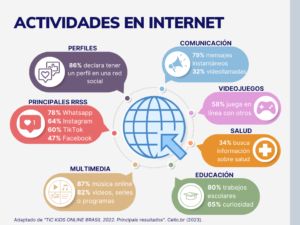Global Kids Online: generating evidence on the use of the Internet among the youngest ones
At a time when electronic devices and digital platforms have come to monopolise every aspect of our life, we must answer a fundamental question: how are the youngest ones adjusting to and navigating this constantly evolving environment? This is the question that Global Kids Online sets out to answer. It’s an international research project that focuses on exploring and understanding how children and young people use the Internet and digital technologies in different parts of the world.
With the collaboration of more than 30 countries and the joint participation of the UNICEF Office of Research – Innocenti, the London School of Economics and Political Science (LSE) and the EU Kids Online network, this project conducts periodic empirical research studies in several countries to compile data on the online behaviours of children, their interactions with digital media, and other related aspects. Its main objective is to generate rigorous evidence on the use of the internet by children and adolescents (NNAs, in its initials in Spanish) by offering valuable information to policy makers, researchers and other actors interested in the protection and well-being of children in the digital environment. At present, countries participating in the project include Albania, Bulgaria, Canada, Costa Rica, Ghana, India, Montenegro, New Zealand, the Filipinos, Serbia, and South Africa; and in Latin America, Argentina, Brazil, Chile and Uruguay have published reports.
Global Kids Online is an international research project that focuses on exploring and understanding how children and young people use the internet and digital technologies in different parts of the world.
ICT Kids Online: a look at the case of Brazil
In Latin America, Brazil has been a pioneer in implementing the studio. Since 2012, it has been conducted annually under the supervision of the Centro Regional para o Desenvolvimento da Sociedade da Informação [Regional Centre for the Development of the Information Society] (Cetic.br), a body that carries out research into the access, use and appropriation of ICT in the country. The ICT Kids Online survey compiles information about NNAs between the ages of 9 and 17, and on their parents or guardians, with the aim of identifying risks and opportunities related to the online use and participation of children and young people in the country. The results of the study reveal a broad use of the Internet at these early ages, making it a focus of attention for parents and guardians, teachers and policy managers. In a context where having updated data and evidence about the use of the internet by this group is increasingly necessary, these findings inform the debates and guide the development of public policies that impact children, to safeguard, protect and promote the democratisation of the safe use of the various digital tools available.
The characteristics of the latest study (2022) are detailed in the following image.

With regard to connectivity, the results reveal that 92% of children and adolescents (NNAs) have access to the internet and 96% of them can regularly connect to the web. However, disparities persist in terms of geographical location: in rural contexts, only 85% of households have internet access. Moreover, it is important to note that almost all people with a stronger socio-economic position have permanent connectivity (99%), in contrast to the most disadvantaged groups (88%).
However, when we delve into the conditions of use of the internet, it becomes clear that access in itself does not guarantee equality. The findings indicate, for example, that connection quality may become a new barrier of inequality in the use of digital tools. Indeed, in the lower social strata, 39% of respondents report that the speed of their service is inadequate and worsening, while 25% are limited in their activities due to credit limitations, compared to 18% and 15%, respectively, in the higher socio-economic brackets.
The supremacy of the mobile phone and the need to strengthen digital skills
In this situation, the mobile phone is the primary device used by 96% of respondents to access the internet, compared to 43%, who use computers. In addition, differences are also apparent depending on users’ socio-economic level, as the most privileged strata have access to a greater diversity of devices (mobile, television, computers, video game consoles), while 82% of the less privileged classes access the Internet exclusively through their mobile phones.
The study also captures the perception of children and adolescents in relation to their abilities to use technological tools, an appreciation that highlights the need to strengthen the development of digital skills as essential competencies for the 21st century. Specifically, participants report that they master those actions they carry out on a daily basis, such as protecting their devices with passwords or other security mechanisms (85%), as opposed to less common actions such as finding out the monetary expense of an application (46%) or handling programming languages (18%).From this evidence, the development of skills for the critical and reflective use of the internet remains a challenge. Essential tasks to verify information account for this challenge: while 70% claim to be able to locate previously visited websites, only 52% can discern if the content they consume is sponsored and 43% consider that the first search result is the best source of information.
These data underline the importance of going further in the development of digital skills in school beyond mere literacy. The recent GEM Report (2023) on technology and education points out that these skills not only change rapidly, but are also largely acquired in informal contexts. In this regard, it is essential to recognise the knowledge that children and adolescents have in the subject, with the aim of guiding teaching actions that promote the learning of more complex skills in the educational system.
the most privileged strata have access to a greater diversity of devices (mobile, television, computers, video game consoles), while 82% of the less privileged classes access the Internet exclusively through their mobile phones.
Online activities: socialisation, information and entertainment
Children and adolescents make frequent use of the internet. While their social media engagement is constantly increasing, this is not the only activity they do online. The study also covers actions such as the search for information and the investigation of issues related to health and well-being.

Internet Privacy: A Critical Aspect of Digital Technologies
An issue that is becoming increasingly important in relation to the use of the internet is related to the identification of risks and the safeguarding of virtual identity. Reports published by the United Nations (2022) and Unicef (2021) warn about the growing concern for the preservation of children’s right to privacy, given the lack of knowledge about the data collected and processed by digital platforms, which could mean threats to their security.
The ICT Kids Online 2022 report incorporates new indicators that address these issues. Although 40% of participants acknowledge using the internet to make new friends, 73% say they are cautious when accepting invitations and 63% say they share posts only with close friends, while 79% say they are careful about the information they share in digital media. On the other hand, actions related to the technical aspects of applications are identified as less common among children and adolescents. For example, 58% say they provide as little information as possible when registering for new websites, and only 55% say they read the privacy conditions of the applications they use.
Regarding the strategies adopted, blocking messages from people with whom they do not want to interact (63%), the use of complex passwords that include various types of characters (58%) and changing privacy settings in profiles (52%) stand out as the most common actions among children and adolescents. It is important to highlight that the results show a higher prevalence of this type of strategy in the female group, as well as its growing adoption in the older segments within the study (15 to 17 years).
A tool to understand online participation during childhood and adolescence
Studies such as ICT Kids Online provide a broad understanding of the behaviours of children and adolescents on the internet, as well as the skills they display while surfing the web. In this context, the information collected by this study becomes an essential resource for formulating strategies from the educational system, contributing to the growth and strengthening of competent citizens in the digital world. The production, selection and management of online content are fundamental skills that children and young people must develop to function and live in highly digitalised educational and social environments.
To learn more about the results of the study in Brazil and access the microdata, we invite you to visit the website of the Centro Regional para o Desenvolvimento da Sociedade da Informação (Cetic.br). In addition, to learn about the Global Kids Online project and explore the details of the various participating countries, we recommend you visit their website. These resources will provide a more complete vision of the valuable work being carried out to understand and promote a safe and enriching participation of children and adolescents in the digital world.






